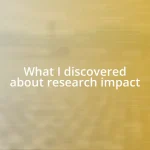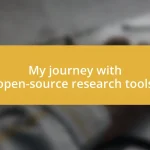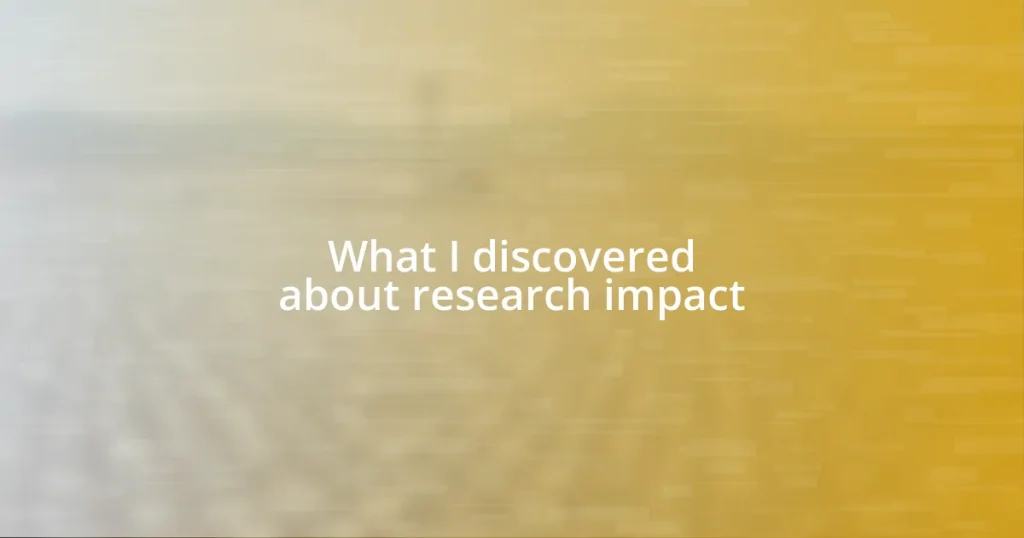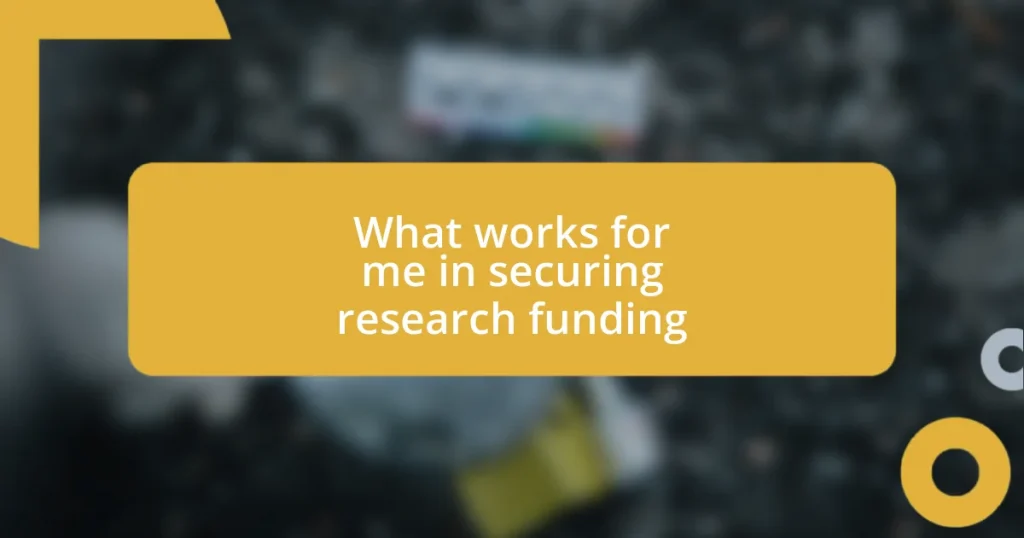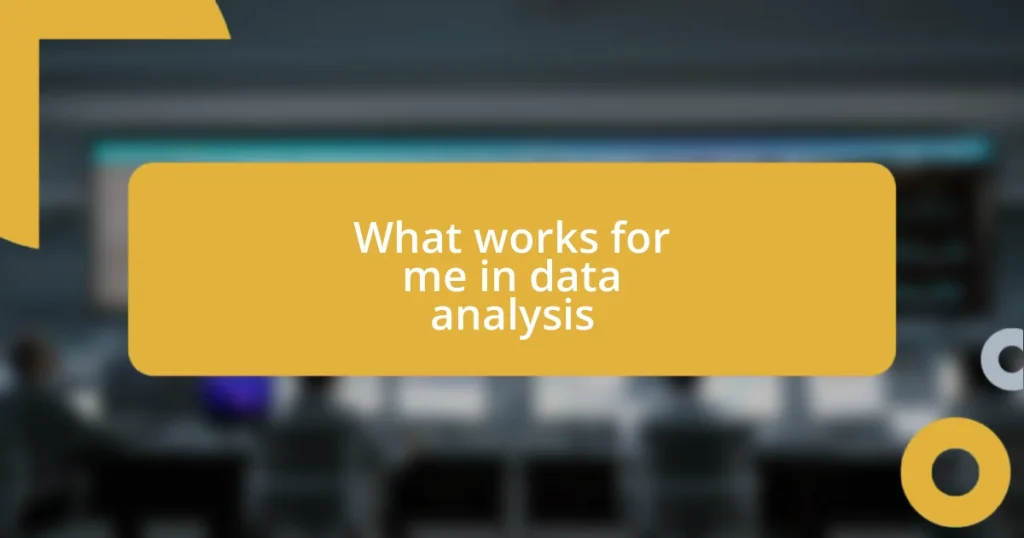Key takeaways:
- Research impact is not solely about metrics; it reflects real-world changes and societal growth influenced by findings.
- Measuring impact validates research value, refines methodologies, and connects with stakeholders, enhancing future support.
- Diverse assessment methods, such as bibliometrics and qualitative studies, provide a comprehensive view of research influence.
- Collaboration, effective communication, and timing are crucial for maximizing research impact and fostering actionable outcomes.

Understanding research impact
Understanding research impact goes beyond just numbers; it’s about the real-world changes that emerge from our findings. I remember attending a conference where a researcher shared how her study on community health directly influenced local policy. It struck me then, how one piece of research can ripple out to tangibly affect lives—what a powerful reminder of our roles as researchers!
Have you ever thought about the ways your research could resonate outside the academic bubble? For me, the moment I realized that my findings on educational methodologies were being used in classrooms was exhilarating. Such moments bring an emotional depth to our work and remind us that at its core, research is about making connections and facilitating growth in society.
It’s fascinating to consider that research impact can manifest in various forms—be it influencing policy, inspiring further research, or even changing public perceptions. I once spoke with a colleague whose groundbreaking study on climate change led to community awareness campaigns. That left me wondering: isn’t the true essence of research to ignite dialogues and provoke action? Understanding these facets of research impact is crucial for crafting work that not only contributes to knowledge but also inspires meaningful change.
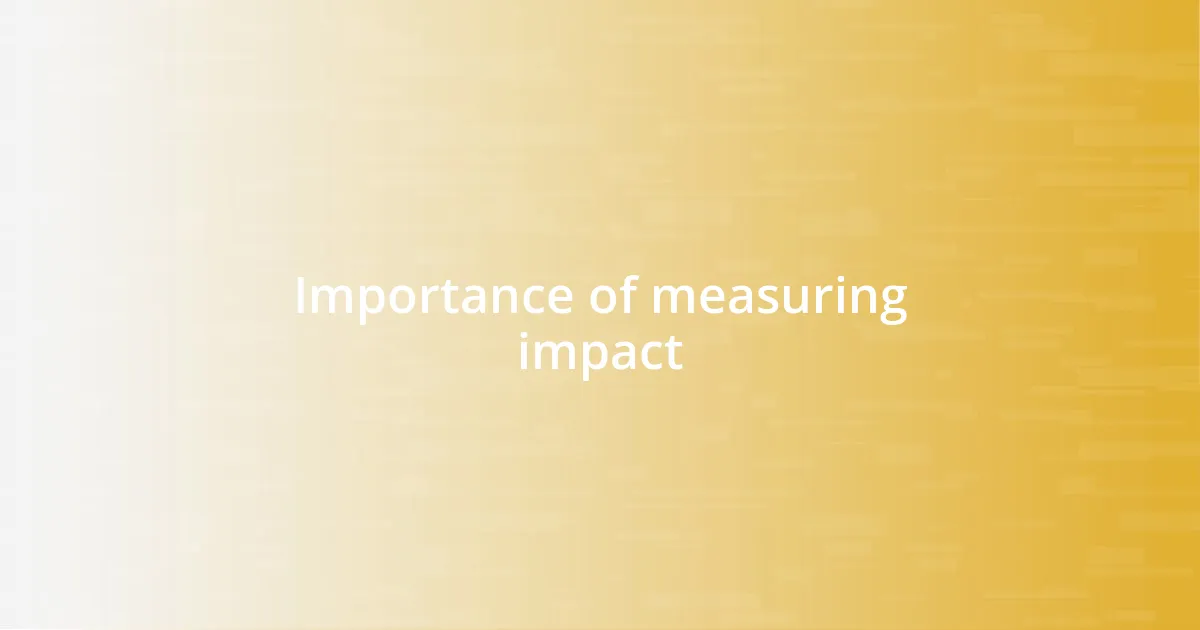
Importance of measuring impact
Measuring impact is essential because it provides a tangible way to demonstrate the value of research. I vividly remember attending a workshop where we analyzed pre-and post-research surveys. The results highlighted that our studies not only increased knowledge but also changed behaviors. Witnessing the shift in perceptions was enlightening—it made me realize just how vital impact measurement is in validating our efforts.
Moreover, understanding the effectiveness of our work allows us to refine our methodologies. In one instance, I evaluated the feedback from a project I was involved in and discovered areas for improvement. Adjusting my approach based on real feedback was impactful; it transformed not just my research but how I connect with individuals in the field. This kind of iterative improvement is a compelling reason to prioritize measuring impact.
Finally, measuring our research impact connects us to stakeholders, funding agencies, and the wider community. During a presentation to potential funders, I shared data reflecting how our research influenced policy decisions. Their interest peaked, and that moment underscored the importance of showcasing our work’s societal relevance. It’s not just about producing findings—it’s about creating a meaningful dialogue that paves the way for future support and collaboration.
| Reasons for Measuring Impact | Personal Experience |
|---|---|
| Validates research value | Analyzed survey results showing behavioral changes |
| Refines methodologies | Adjusted approach based on project feedback |
| Connects with stakeholders | Shared impactful data with potential funders |
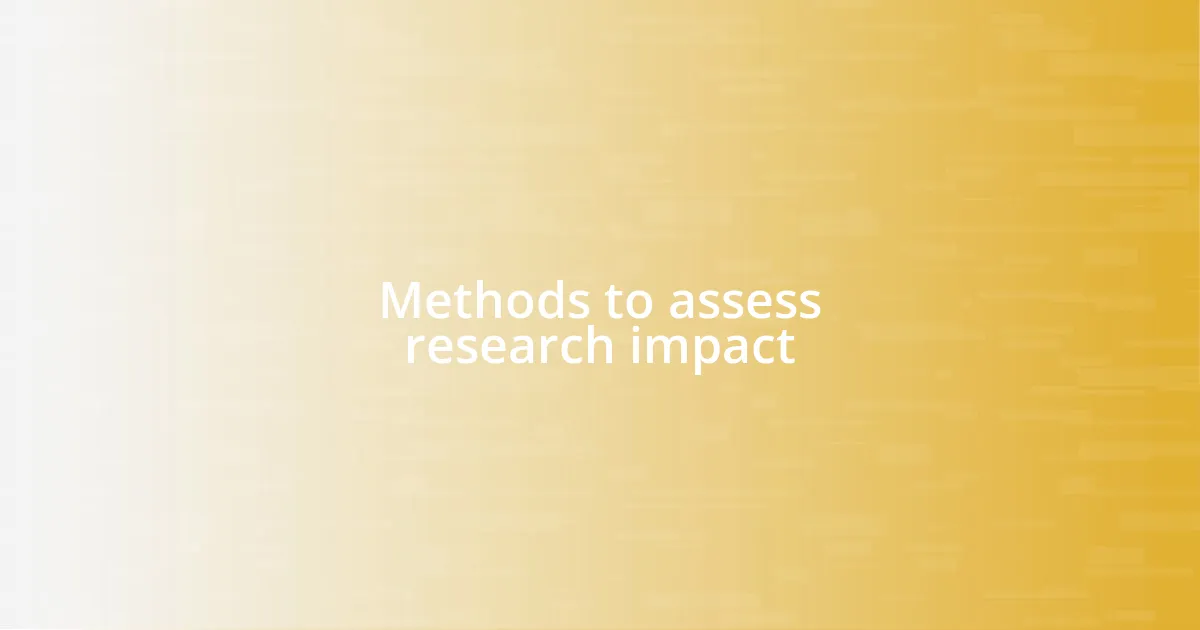
Methods to assess research impact
Assessing research impact can be approached through a variety of methods. One of the more effective methods I’ve encountered is the use of bibliometrics, which involves analyzing citation patterns to gauge how often research is referenced by other scholars. It’s quite interesting to see how my own work on behavioral science received citations that extended into policy literature—I still remember the thrill of discovering that my research was integral to shaping new community outreach programs.
In addition to bibliometrics, qualitative assessments, such as interviews and case studies, can provide a deeper understanding of impact. I’ve found that speaking directly with practitioners implementing research findings unveils profound insights about its real-life effects. For example, I once conducted interviews with teachers who integrated themes from my work into their lesson plans. Hearing their reflections on how these ideas sparked student engagement was not just validating; it reignited my passion for research. Here are some additional methods for assessing research impact:
- Surveys and questionnaires: Collect feedback from the audience influenced by your research.
- Social media analysis: Monitor online discussions and shares related to your findings.
- Policy analysis: Examine changes in legislation or guidelines that cite your work.
- Impact case studies: Create detailed narratives showcasing specific instances where your research made a difference.
- Collaboration with industry: Partner with organizations to evaluate how research outcomes are being implemented.
By diversifying the assessment methods, I appreciate how they can help illuminate not just the breadth of impact but also the depth, creating a fuller picture of how research can ripple through various communities and disciplines.
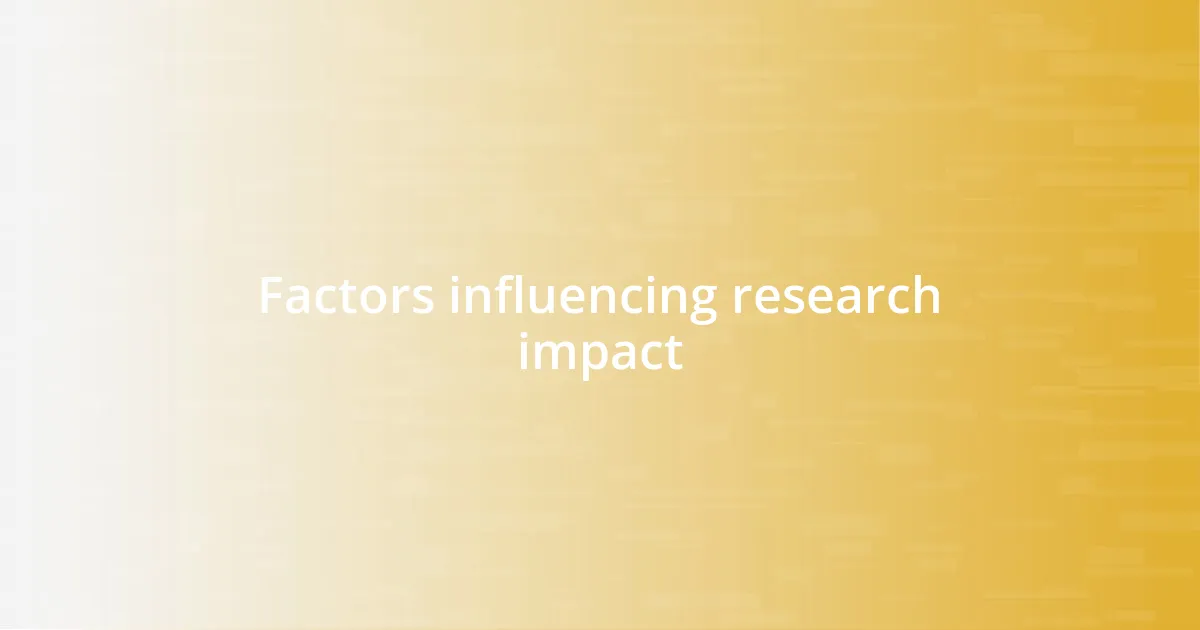
Factors influencing research impact
When I consider the factors influencing research impact, collaboration stands out prominently. Engaging with diverse stakeholders can dramatically enhance the relevance of findings. I recall a project where I partnered with local health organizations; their insights brought real-world context to my research. This collaboration not only enriched my work but also ensured that our findings translated into actionable strategies for the community.
Another crucial factor is the clarity of communication. I’ve seen how effectively presenting research through accessible language and engaging formats can broaden its reach. For instance, I once transformed a detailed report into a series of short videos. The feedback was overwhelming; viewers expressed how much easier it was to grasp the core concepts. Have you ever noticed how a compelling narrative can draw people into even the most complex topics? It’s a lesson in understanding the audience and meeting them where they are.
Finally, the timing of your research plays an undeniable role in its impact. I remember releasing a study on educational methods just as a major policy shift was being debated. The media coverage was intense, and my work gained traction almost overnight. It reinforced the idea that being attuned to the broader landscape can amplify the reception and relevance of your research. Have you thought about how timing influences the conversations around your work? Catching that wave can open up significant opportunities for visibility and engagement.
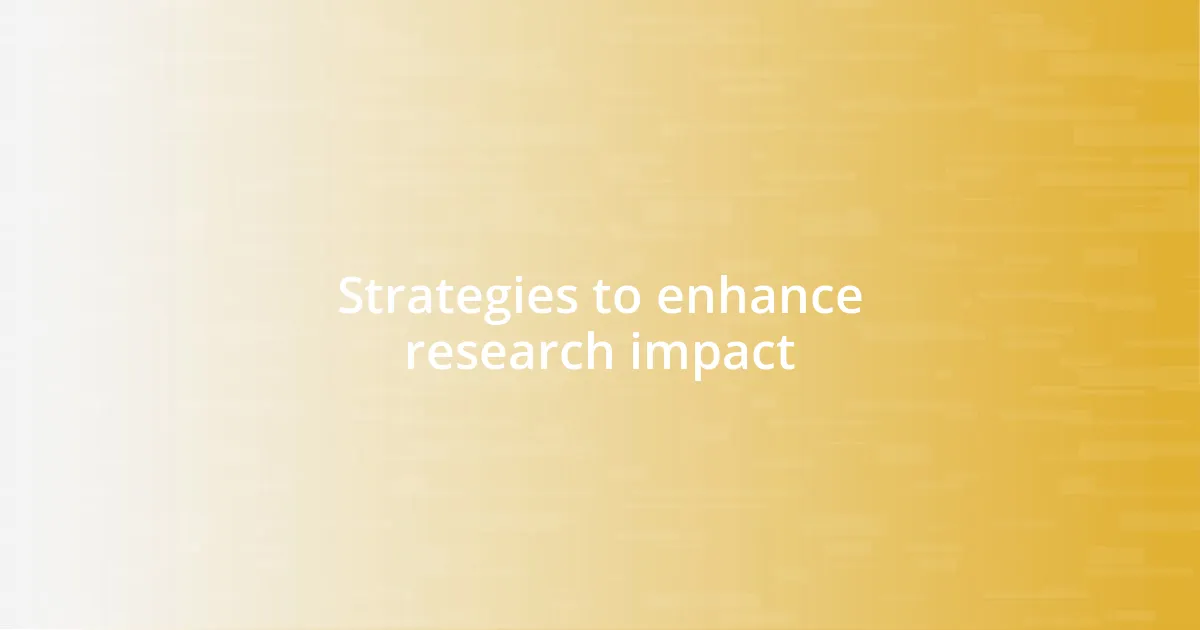
Strategies to enhance research impact
One strategy I’ve found invaluable is creating partnerships with community organizations. When I collaborated with a non-profit focused on environmental sustainability, their on-the-ground insights directed my research focus. I remember standing in a community garden, hearing residents express their concerns about pollution—what a pivotal moment! By tailoring my findings to address these specific issues, the research not only gained visibility but also fostered real, actionable outcomes that the community embraced.
Another effective approach lies in harnessing the power of digital platforms. I’ve taken my research findings and turned them into engaging infographics and interactive webinars. It’s fascinating to see how a simple visual representation can spark discussions that my dense academic papers never did. Have you ever thought about how visuals can break down complex ideas? That realization truly changed my approach to sharing research, making it more approachable and appealing to various audiences.
I also highly recommend leveraging storytelling in your presentations and publications. I recall presenting at a conference where I showcased my findings through personal narratives and case studies. The room was palpable with energy as attendees connected emotionally with the stories I shared. So, why does storytelling work so well in research impact? It aligns data with human experiences, making the research not just informative but also relatable. When your audience sees themselves in your work, that’s where the magic really happens!
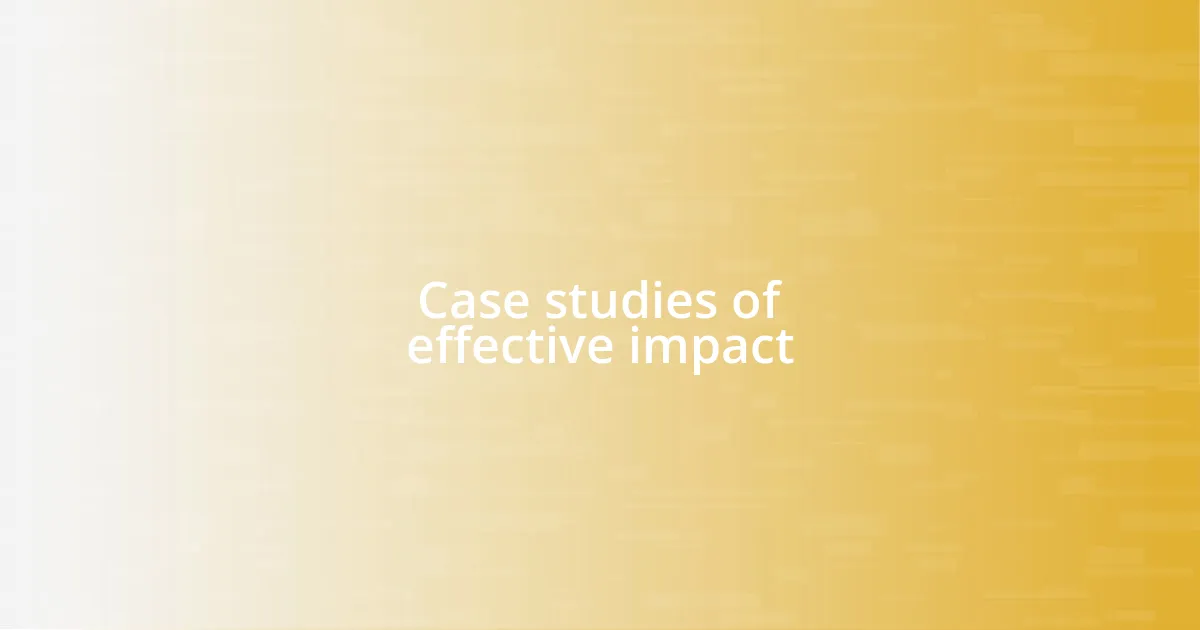
Case studies of effective impact
One of the most striking case studies I encountered came from a climate research initiative, which collaborated with indigenous communities. I vividly recall reading about how these communities contributed traditional knowledge about local ecosystems. This blending of modern science and ancestral wisdom led to more effective environmental policies, demonstrating that respect for diverse perspectives can yield richer outcomes. Isn’t it fascinating how collaboration across cultures can deepen the insights of scientific research?
Another memorable example involved a health research project focusing on mental health interventions in schools. The researchers partnered with students to co-create engaging workshops tailored to their peers. I remember feeling inspired by the students’ enthusiastic participation; they brought fresh language and relatable scenarios into the sessions. This approach not only boosted attendance but also led to a tangible improvement in students’ well-being. Have you ever thought about how involving your audience in the process can enhance the impact of your research?
A particularly impactful case study I came across revolved around agricultural innovation. Researchers worked hand in hand with farmers to develop sustainable practices that directly reflected their needs and realities. I was struck by a farmer’s story of how a simple change in crop rotation increased yields significantly. It was a powerful reminder that, sometimes, the most effective solutions stem from listening to those on the ground. Doesn’t it make you wonder how many breakthroughs might be hidden within the experiences of everyday practitioners?
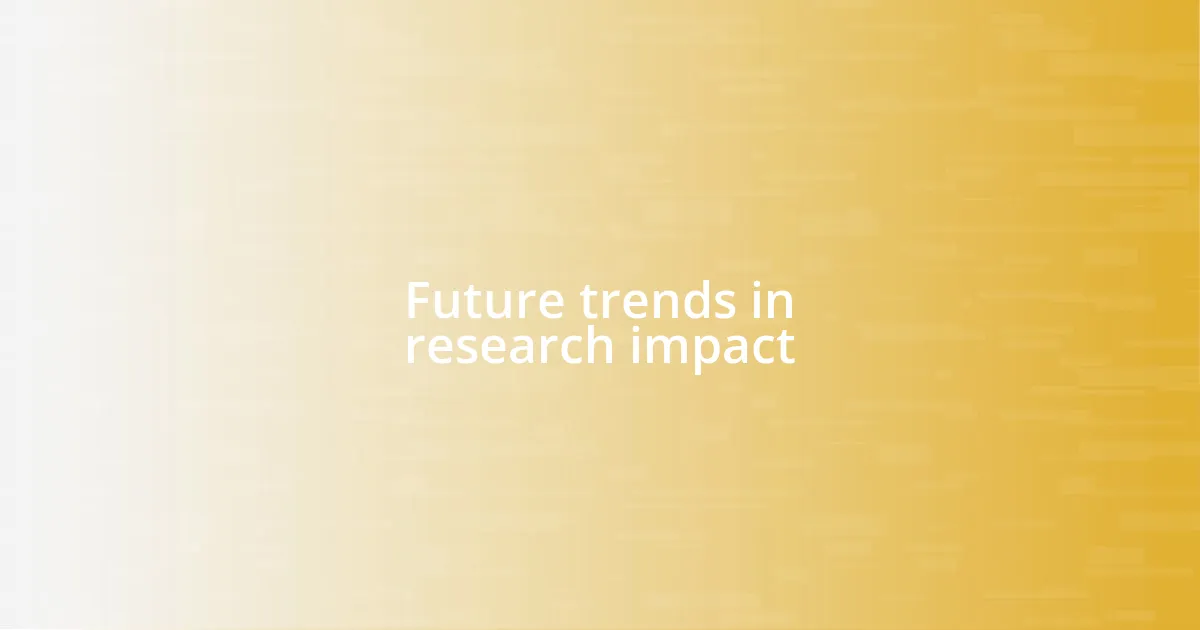
Future trends in research impact
As I consider future trends in research impact, I can’t help but reflect on the growing role of data visualization. Recently, while attending a seminar on big data, I saw firsthand how vibrant graphics illuminated complex datasets. Isn’t it interesting how these visuals can distill intricate concepts into digestible forms? I believe that as researchers embrace this trend, our work will resonate more deeply with diverse audiences, making even the most challenging subjects accessible and engaging.
I also see an increasing emphasis on interdisciplinary collaboration. In my experience, connecting with experts from fields outside my own has often led to surprising insights. I remember a project where a partnership with sociologists brought new dimensions to my environmental research—challenging preconceived notions and expanding the impact. Don’t you think blending perspectives can reveal innovative solutions that might otherwise remain hidden?
Lastly, I sense a shift toward a greater focus on measuring social impact beyond traditional metrics. Taking part in a recent workshop, I was inspired by discussions on qualitative measures that capture real-life changes. These conversations prompted me to question: how do we define success in research? I strongly believe that when we prioritize human stories and lived experiences, we enrich the narrative of research impact, making it not just about numbers, but about meaningful change in people’s lives.


